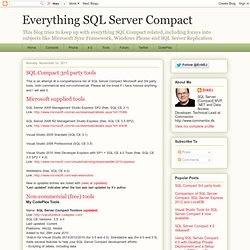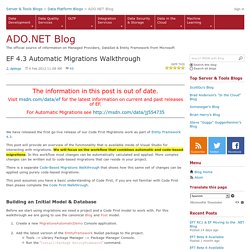

SQL Compact 3rd party tools. This is an attempt at a comprehensive list of SQL Server Compact Microsoft and 3rd party tools, both commercial and non-commercial.

Please let me know if I have missed anything, and I will add it. Microsoft supplied tools SQL Server 2005 Management Studio Express SP2 (free, SQL CE 3.1)Link: SQL Server 2008 R2 Management Studio Express (free, SQL CE 3.5 SP2)Link: Code-First Development (EF) w/ SQL CE 4.0. I’ve been playing with the new Microsoft WebMatrix IDE.

It’s a very neat little piece of software that takes the effort out of many things. It’s great for small Web projects. The problem with out-of-the-box WebMatrix development is that it encourages you to use direct SQL programming with embedded SQL queries. The world has moved away from embedded SQL queries in favor of object-relational mapping and (domain-un-specific) query syntax such as LINQ. I wanted to test out using LINQ2SQL with WebMatrix. The problem, though, is that SQLmetal does not appear to work with SQL CE 4.0. Microsoft’s next-generation O-R mapper – Entity Framework (EF) – is one possibility. Microsoft has three basic strategies for using the Entity Framework (very roughly):
.net - Generate SQL CE database from EF Code-First DbContext class. Windows Azure HDInsight - Welcome. Entity Framework and Open Source. The Entity Framework has advanced significantly over the last few years. A little over a year ago we released EF 4.1, which introduced the new DbContext API and EF “Code First” support. Earlier this year we delivered EF 4.3, which provides Code First Migration support that enables developers to easily evolve database schema in a code optimized way. And we are now in the final stages of wrapping up the EF 5 release, which adds enum support, spatial data types, table-valued function support and some significant performance and Visual Studio Tooling improvements. One of the things the team has done throughout the EF4 and EF5 development cycles has been to involve the community early as we make design decisions and solicit as much feedback as possible.
Going forward with EF 6 we are looking to take this to the next level by moving to an open development model. Same Support, Same Developers, More Investment The team is really excited to move to this more open development approach. Learn More. RavenDB - 2nd generation document database. Mono 2.11.3 is out. EF 4.3 Automatic Migrations Walkthrough - ADO.NET Blog. The information in this post is out of date.

Visit msdn.com/data/ef for the latest information on current and past releases of EF. For Automatic Migrations see We have released the first go-live release of our Code First Migrations work as part of Entity Framework 4.3. This post will provide an overview of the functionality that is available inside of Visual Studio for interacting with migrations. We will focus on the workflow that combines automatic and code-based migrations. There is a separate Code-Based Migrations Walkthrough that shows how this same set of changes can be applied using purely code-based migrations.
This post assumes you have a basic understanding of Code First, if you are not familiar with Code First then please complete the Code First Walkthrough. Building an Initial Model & Database Before we start using migrations we need a project and a Code First model to work with. Create a new MigrationsAutomaticDemo Console application. . Enabling Migrations Getting a SQL Script. C# - How to read the response stream before the Http response completes.
Getting RAW Soap Data from a Web Reference Client running in ASP.net. Under the hood of DataReader. First, let's make sure we understand our terms. 1. Server is the database server 2. Client is the software getting data (the one that opened the connection). This can be a fat client or a web app. The method of the data reader is simliar to any fast forward (firehose) cursor on the server side. The information is streamed directly from the database. When the DataReader is read, each "row" is destroyed from the stream (buffer) as it is consumed. I know of a programmer who only uses DataReaders. -- Gregory A. ************************************************** ******************** Think Outside the Box! Hi,My friend had a little confusion about the working of DataReader after reading an article from MSDN. Continuous data stream.